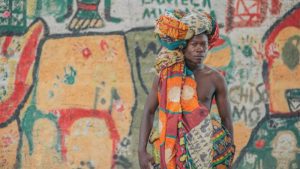From the Series
Back in 1983, Chuck Hull printed the first 3D-printed object. By contemporary standards his first print – a small black eyewash cup – was quite boring. Today, Hull is celebrated as the father of 3D printing, and the products of 3D printing are far from boring – from 3D printed ravioli to epilepsy drugs, 3D printed replicas of Homo Naledi and sex toys.
But outside of 3D printing pasta and pills, 3D printing also holds the potential to significantly undermine traditional manufacturing methods because, instead of massive factories running on expensive equipment, 3D printing makes light, decentralised production possible.
This means that many goods will be produced on site, where the resources are. That kind of technology can effectively include and benefit the world’s most marginalised people – all that is required are creative communities and makers to spearhead the movement.
Should the technology take off in marginalised communities, it could be used to make the inexpensive medical interventions that people in the most disadvantaged African communities need, define a future-focused curriculum in schools and forge ahead, exploring the next frontier of human settlement.
The power of 3D printing lies in tapping into local needs and inspiring creativity." – Professor Calestous Juma, Harvard Kennedy School, NewAfrican.
This potential to assist in response to African development and humanitarian challenges will only increase as 3D printers become more sophisticated and affordable.
Cost is admittedly a limitation but as Togolese inventor Afate Gnikou showed, that problem is not without a solution. Gnikou built a 3D printer from electronic waste collected from scrapyards around Lomé, the capital city of Togo. The working prototype cost him just $100. Should the cost plummet, the technology has many qualities that could enable Africa to leapfrog into a new age of production.
Image: Daniel Haydouk
Outside of cost and accessibility the question then becomes whether or not African communities will grasp the transformational power of 3D printing. The answer isn’t a definite yes, but it is already becoming apparent that some creators are taking the tech and putting it to good use in education, medicine, energy, wildlife, and women’s empowerment across Africa. We track just how far 3D printing penetration is.
Medicine
3D printed technology is steadily affecting medical practice in Africa. The most notable intervention is in printing prosthetic limbs and sockets such as the one that a three-year-old Ugandan, Rosaline, received. Rosaline’s prosthetic and socket cost $250 – a fraction of the normal $5 000 price tag. The process is faster, the prosthetic can be printed in a day, and amputees report a more comfortable fit.
Image: Image: Gingercoons/Sephamore Research Cluster.
Earlier this year, the US Food and Drug Administration approved Spritam, an anti-seizure drug and the first 3D-printed pill. With this kind of technology it can become possible (at some stage) to print pharmaceutical drugs at home or for example in the future, mobile clinics in Sub-Saharan Africa could print their own antiretroviral drugs.
Zambian scientist Priscilla Lumano-Mulanga, of the Vanderbilt-Zambia Network for Innovation in Global Health Technologies, is working on a project to create a 3D printed device that enhances the capabilities of existing malaria testing technology the 3D printed device delivers more accurate results faster.
Image: 3ders.com
Energy
A group of 50 Australian scientists, members of the Victorian Organic Solar Cell Consortium, are working on 3D printing paper-thin solar panels. The scientists claim that the printable panels are capable of powering entire skyscrapers. But it isn’t necessarily high-rise buildings that will benefit Africa the most. The panels can be fitted on walls, windows and floors reducing the dependence on national providers such as Eskom and provide energy to remote areas.
Image: insidide3dp.com
Peppermint Energy used 3D printing technology to print functional prototypes of FORTY2, a portable generator that draws enough energy from the sun to provide light, refrigerate medicine or goods, or power a laptop. When the sun is down, a battery connected to the array stores power for use.
Image: cdns.nocamels.com
Solar Energy is already making an impact in rural Kenya, where Masaai women tote panels on donkey back and install them in homes in the community.
Education
Non-profit company Youth For Technology (YFT) exposes school children in the Niger Delta, especially girls, to 3D printing technology to get them engaged and interested in STEM subjects – Science, Technology, Engineering and Mathematics.
“Girls in Youth for Technology's 3D Africa program learn to use 3D printing technology to print things like jewellery, phone cases, and art,” says an out-dated YFT Indigogo page. “Behind the scenes, and with your support, 3D Africa can help close the STEM gender skills gap.”
Image: youthfortechnology.com
We are a long way from making 3D printing ubiquitous but by teaching children to use the technology while they’re still in school chances are they’ll be “3D-printing natives” by the time they’re working adults.
“Pound for pound, rhino horn is more valuable than gold”
Pembient, a San Francisco-based Biotech company, plans to combat poaching by 3D-printing rhino horns.
[Using Keratin] We can produce a rhinoceros horn product that is actually more pure than what you can get from a wild animal,” – Matthew Markus, Pembient CEO, told FastCoexist.
Environmentalists are not optimistic. The executive director of the International Rhino Foundation, Susie Ellis, told Quartz the solution is not as simple as Pembient has made it out to be. They fear that the “faux-horn” will drive the desire for the real thing higher further endangering the few rhinos that do exist.
Pembients 3D printed "rhino horn". Image: techcrunch.com
Women
With support from the Bill and Melinda Gates Foundation, the 3D4AgDev programme of the National University of Ireland (Galway) is experimenting with 3D printing and agriculture.
The goal of the 3D4AgDev Program is to use end-user research together with Rapid Prototyping – via 3D printing – to enable women smallholder farmers in Africa to design and develop their own labour-saving agricultural tools that are tailor-made for their ergonomics, culture, soils and cropping systems. Labour saving tools enable farmers to generate more income and agricultural produce while reducing the labour burden on women and rural children so that their livelihoods can improve.
The global 3D printing industry is growing at nearly 46% annually. The world market was worth about $2.5 billion in 2013 and its value is projected to exceed $16 billion by 2018." – NewAfrican.
3D printing in low resource environments is unique. While Africa is yet to find its growth path using the technology, it may add more than take away from the continent. There is, of course, no need to be over zealous about the technology. It has its limitations but it does add hope to a continent that is propelling forward faster than expected.














